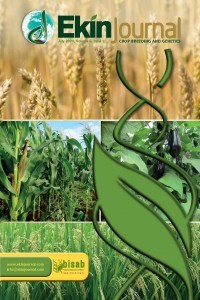Analysis of Sesame (Sesamum indicum L.) Accessions Collected From Different Parts of Turkey Based on Qualitative and Quantitative Traits
Analysis of Sesame (Sesamum indicum L.) Accessions Collected From Different Parts of Turkey Based on Qualitative and Quantitative Traits
An experiment was conducted at the experimental area of Dicle University Faculty of Agriculture, Department of
Field Crops in 2014 growing season. A total of 107 diverse sesame accessions collected from Mediterranean, Aegean
and Southeastern Anatolia Region of Turkey were sown on 3 May 2014. The experiment was laid out in an
augmented experimental design with eleven replications. A total of 25 morphological and agronomical characters
of 107 sesame accessions were evaluated following to IPGRI (International Plant Genetic Resources Institute)
descriptors of sesame, and the obtained data were evaluated according to their qualitative and quantitative traits.
Frequency distribution of qualitative traits and correlation coefficients of quantitative traits were determined.
According to the frequency of accessions analyzed, the variability in terms of the qualitative traits examined. Regarding
the relationship between quantitative traits, the number of capsules, 1000 seed weight and harvest index
were determined significantly affecting the seed yield.
Keywords:
Sesame, diversity, accession, correlation qualitative and quantitative traits,
___
- Bedigian, D.,Harlan J.R. 1986, Evidence for cultivation of sesame in the ancient world, Economic Botany, 40 (2): 137-139. Bedigian, D.H., van der Maesen, L.J.G., 2003 Slimy leaves and oily seeds: Distribution use of sesamum spp. and Ceratotheca sesamodies (Pedaliaceae) in Africa. In: Schemelzer, G.H. and Omino, B.A., eds.: Proceeding of the first PROTA (Plant Resources of Tropical Africa) International Workshop, Nairobi, Prota Foundation, Wageningen, The Netherlands. Gupta VK, Gupta YK 1977,Variability, interrelationship and path-coefficient analaysis for some quantitative characters in Sesame. Indian Journal of Heredity 9(1):31-37 Hintum Th.J.L. Van 1995. Hierarchical approaches to the analysis of genetic diversity in crop plants.In: T. Hodgkin, A.H.D. Brown, Th.J.L van Hintum & E.A.V. Morales (Eds).John Wiley & Sons. IPGRI, NBPGR, 2004. Descriptors for Sesame (Sesamum spp.), International Plant Genetic Resources Institute, Rome, Italy and National Bureau of Plant Genetic Resources, New Delhi, India. Jeffers, J.N.R. 1967. Two case studies in the application of principal component analysis. Appl. Stat., 16: 225-236. Majumdar SK, Barik KC, Bera PS, Ghosh DC 1987, Path coefficient analysis in sesame (Sesamum indicum L.) with varying levels of nitrogen and potassium. Indian Agriculturist 31: 165-169 Mohammadi, S.A., Prassana, B.M., 2003. Analysis of genetic diversity in crop plants-salient statistical tools and considerations, Crop Sci., 43:1235–1248. Pathak HC, Dixit SK 1992, Genetic variability and interrelationship studies in black seeded sesame (Sesamum indicum L.) Madras Agricultural Jornal 79: 94-100 Purseglove, J.W. 1977. Tropical crops: Dicotyledons. Longman Group, London, Third Edition, London, 719p. Reddy CDR, Haripriya S 1992, Genetic character association and path coefficient analysis in parents and their F1 sesame. J. Maharashtra Agric. Univ. 17: 55-57 Solanki Z.S. and D.Gupta. 2002. Genetic divergence for seed yield and other characters in sesame (Sesamum indicum L.). Journal of Oilseeds Research, 19:35-37. Sudhakar N., O. Sridevi and P.M. Salimath. 2006. Genetic divergence in sesame (Sesamum indicum L.). Journal of Oilseeds Research, 23:295-296. Sumathi, P., V. Muralidharan and N. Manivannan. 2007. Trait association and path coefficient analysis for yield and yield attributing traits in sesame (Sesamum indicum L). Madras Agric. J., 94: 174-178. Uzun, B. and M.I. Cagirgan. 2001. Path-coefficient analysis for seed yield and related characters in a population of determinate and indeterminate types of sesame (Sesamum indicum L.). Turk. J. Field Crops, 6: 76-80. K. Venkataramana Bhat, Prashant P. Babrekar & Suman Lakhanpaul. 1999. Study of genetic diversity in Indian and exotic sesame (Sesamum indicum L.) germplasm using random amplified polymorphic DNA (RAPD) markers. Euphytica 110: 21-33. Varshney, R. K., Close, T. J., Singh, N. K., Hoisington, D. A., and Cook, D. R. 2009. Orphan legume crops enter the genomics era. Current opinion in plant biology, 12(2):202- 210. Yogranjan, G.K. Satpute and S.P. Mishra, 2015. Genetic and genomic intervention to upsurge nutritive values of sesame (Sesamum indicum L.). Asian J. Sci. Technol., 6: 1296-1303
- ISSN: 2149-1275
- Yayın Aralığı: Yılda 2 Sayı
- Başlangıç: 2015
- Yayıncı: Bitki Islahçıları Alt Birliği
Sayıdaki Diğer Makaleler
Molecular Characterization of Some Triticale Cultivars in Turkey
Additional Sources of Resistance for Southern Corn Leaf Blight in Indian Maize Germplasm
Breeding for Adaptation Traits of Wheat in Eastern European Environments the Hungarian Example
Helicoverpa Resistant Chickpea Plants: From Bt Toxins to Plant-Mediated RNAi
